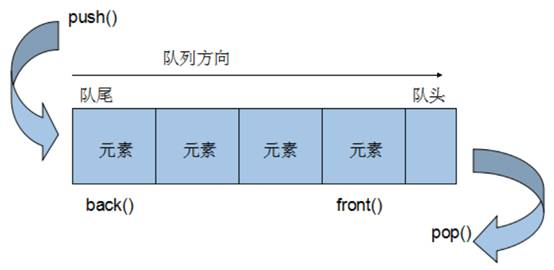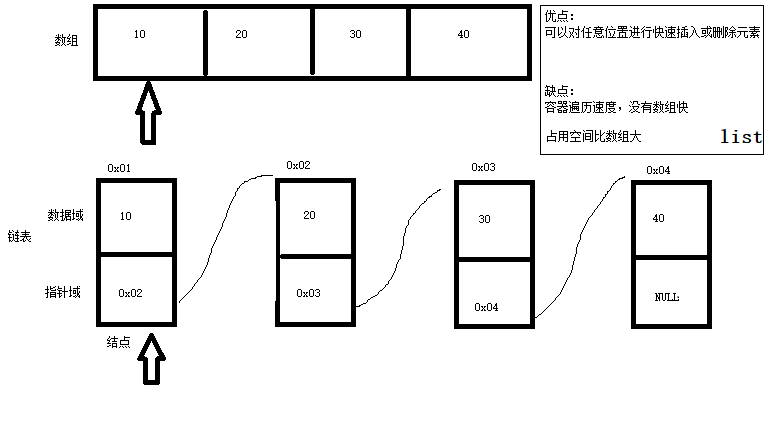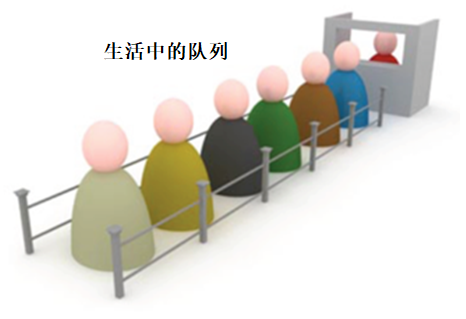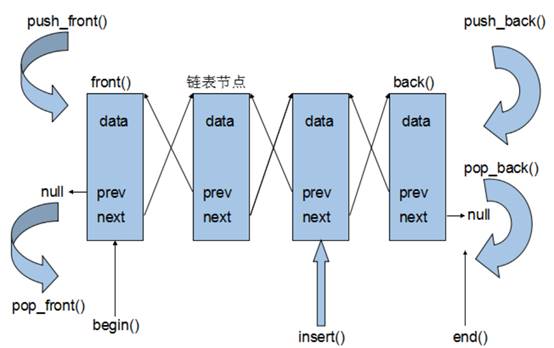目录
3、STL常用容器
3.6、queue容器
3.6.1、queue基本概念
概念:Queue是一种先进先出(First In First Out,FIFO)的数据结构,它有两个出口。

队列容器允许从一端新增元素,从另一端移除元素。
队列中只有队头和队尾才可以被外界使用,因此队列不允许有遍历行为。
队列中进数据称为——入队
push,队列中出数据称为——出队pop。
queue队列的基本概念
3.6.2、queue常用接口
功能描述:栈容器常用的对外接口。
构造函数:
-
queue<T> que;//queue采用模板类实现,queue对象的默认构造形式 -
queue(const queue &que);//拷贝构造函数
赋值操作:queue& operator=(const queue &que); //重载等号操作符
数据存取:
-
push(elem);//往队尾添加元素 -
pop();//从队头移除第一个元素 -
back();//返回最后一个元素 -
front();//返回第一个元素
大小操作:
-
empty();//判断堆栈是否为空 -
size();//返回栈的大小
示例:
#include <iostream>
#include <string>
#include <queue>//队列Queue
using namespace std;
class Person {
public:
Person(string name, int age) {
this->m_Name = name;
this->m_Age = age;
}
string m_Name;
int m_Age;
};
void test01() {
queue<Person> q;//创建队列
//准备数据
Person p1("唐僧", 30);
Person p2("孙悟空", 1000);
Person p3("猪八戒", 900);
Person p4("沙僧", 800);
//向队列中添加元素,入队操作
q.push(p1);
q.push(p2);
q.push(p3);
q.push(p4);
cout << "队列大小为:" << q.size() << endl;//4
//队列不提供迭代器,更不支持随机访问
//判断只要队列不为空,查看队头,查看队尾,出队
while (!q.empty()) {
//查看队头,输出队头元素
cout << "队头元素 --- 姓名:" << q.front().m_Name << ",年龄:" << q.front().m_Age << endl;
//查看队尾
cout << "队尾元素 --- 姓名:" << q.back().m_Name << ",年龄:" << q.back().m_Age << endl;
q.pop();//出队,弹出队头元素
cout << endl;
}
cout << "队列大小为:" << q.size() << endl;//0
}
int main() {
test01();
system("pause");
return 0;
}总结:
-
入队——push;
-
出队——pop;
-
返回队头元素——front;
-
返回队尾元素——back;
-
判断队是否为空——empty;
-
返回队列大小——size。
3.7、list容器
3.7.1、list基本概念
功能:将数据进行链式存储。
链表(list)是一种物理存储单元上非连续的存储结构,数据元素的逻辑顺序是通过链表中的指针链接实现的。
链表的组成:链表由一系列结点组成;结点的组成:一个是存储数据元素的数据域,另一个是存储下一个结点地址的指针域。
STL中的链表是一个双向循环链表。

list容器的基本概念 由于链表的存储方式并不是连续的内存空间,因此链表list中的迭代器只支持前移和后移,属于双向迭代器。
list的优点:
-
采用动态存储分配,不会造成内存浪费和溢出;
-
链表执行插入和删除操作十分方便,修改指针即可,不需要移动大量元素。
list的缺点:链表灵活,但是空间(指针域)和时间(遍历)额外耗费较大。
List有一个重要的性质,插入操作和删除操作都不会造成原有list迭代器的失效,这在vector是不成立的。
总结:STL中List和vector是两个最常被使用的容器,各有优缺点。
3.7.2、list构造函数
功能描述:创建list容器。
函数原型:
-
list<T> lst;//list采用采用模板类实现,对象的默认构造形式: -
list(beg,end);//构造函数将[beg, end)区间中的元素拷贝给本身。 -
list(n,elem);//构造函数将n个elem拷贝给本身。 -
list(const list &lst);//拷贝构造函数。
示例:
#include <iostream>
#include <list>
using namespace std;
//list容器构造函数
void printList(const list<int> &L) {
for (list<int>::const_iterator it = L.begin(); it != L.end(); it++) {
cout << *it << " ";
}
cout << endl;
}
void test01() {
//创建list容器
list<int> L1;//默认构造
//添加数据
L1.push_back(10);
L1.push_back(20);
L1.push_back(30);
L1.push_back(40);
//遍历容器
printList(L1);//10 20 30 40
//区间方式构造
list<int> L2(L1.begin(), L1.end());
printList(L2);//10 20 30 40
//拷贝构造
list<int> L3(L2);
printList(L3);//10 20 30 40
//n个elem
list<int> L4(10, 11);
printList(L4);//11 11 11 11 11 11 11 11 11 11
}
int main() {
test01();
system("pause");
return 0;
}总结:list构造方式同其他几个STL常用容器,熟练掌握即可。
3.7.3、list赋值和交换
功能描述:给list容器进行赋值,以及交换list容器。
函数原型:
-
assign(beg, end);//将[beg, end)区间中的数据拷贝赋值给本身。 -
assign(n, elem);//将n个elem拷贝赋值给本身。 -
list& operator=(const list &lst);//重载等号操作符 -
swap(lst);//将lst与本身的元素互换。
示例:
#include <iostream>
#include <list>
using namespace std;
// list容器赋值和交换
void printList(const list<int> &L) {
for (list<int>::const_iterator it = L.begin(); it != L.end(); it++) {
cout << *it << " ";
}
cout << endl;
}
//赋值和交换
void test01() {
list<int> L1;
L1.push_back(10);
L1.push_back(20);
L1.push_back(30);
L1.push_back(40);
printList(L1);
//赋值
list<int> L2;
L2 = L1;//operator=赋值
printList(L2);
list<int> L3;
L3.assign(L2.begin(), L2.end());
printList(L3);
list<int> L4;
L4.assign(10, 100);
printList(L4);
}
//交换
void test02() {
list<int> L1;
L1.push_back(10);
L1.push_back(20);
L1.push_back(30);
L1.push_back(40);
list<int> L2;
L2.assign(10, 100);
cout << "交换前:" << endl;
printList(L1);
printList(L2);
cout << endl;
L1.swap(L2);
cout << "交换后:" << endl;
printList(L1);
printList(L2);
}
int main() {
test01();
test02();
system("pause");
return 0;
}总结:list赋值和交换操作能够灵活运用即可。
3.7.4、list大小操作
功能描述:对list容器的大小进行操作。
函数原型:
-
size();//返回容器中元素的个数 -
empty();//判断容器是否为空 -
resize(num);//重新指定容器的长度为num,若容器变长,则以默认值填充新位置;如果容器变短,则末尾超出容器长度的元素被删除。 -
resize(num, elem);//重新指定容器的长度为num,若容器变长,则以elem值填充新位置;如果容器变短,则末尾超出容器长度的元素被删除。
示例:
#include <iostream>
#include <list>
using namespace std;
//list容器大小操作
void printList(const list<int> &L) {
for (list<int>::const_iterator it = L.begin(); it != L.end(); it++) {
cout << *it << " ";
}
cout << endl;
}
//大小操作
void test01() {
list<int> L1;
L1.push_back(10);
L1.push_back(20);
L1.push_back(30);
L1.push_back(40);
printList(L1);
//判断容器是否为空
if (L1.empty()) {
cout << "L1为空!" << endl;
} else {
cout << "L1不为空!" << endl;
cout << "L1的元素个数为:" << L1.size() << endl;
}
//重新指定大小
//L1.resize(10);
L1.resize(10, 10000);
printList(L1);//10 20 30 40 10000 10000 10000 10000 10000 10000
L1.resize(2);
printList(L1);//10 20
}
int main() {
test01();
system("pause");
return 0;
}总结:1.判断是否为空——empty;2.返回元素个数——size;3.重新指定个数——resize。
3.7.5、list插入和删除
功能描述:对list容器进行数据的插入和删除。
函数原型:
-
push_back(elem);//在容器尾部加入一个元素
-
pop_back();//删除容器中最后一个元素
-
push_front(elem);//在容器开头插入一个元素
-
pop_front();//从容器开头移除第一个元素
-
insert(pos, elem);//在pos位置插elem元素的拷贝,返回新数据的位置。
-
insert(pos, n, elem);//在pos位置插入n个elem数据,无返回值。
-
insert(pos, beg, end);//在pos位置插入[beg, end)区间的数据,无返回值。
-
clear();//移除容器的所有数据
-
erase(beg, end);//删除[beg, end)区间的数据,返回下一个数据的位置。
-
erase(pos);//删除pos位置的数据,返回下一个数据的位置。
-
remove(elem);//删除容器中所有与elem值匹配的元素。
示例:
#include <iostream>
#include <list>
using namespace std;
//list容器插入和删除
/*
- push_back(elem);//在容器尾部加入一个元素
- pop_back();//删除容器中最后一个元素
- push_front(elem);//在容器开头插入一个元素
- pop_front();//从容器开头移除第一个元素
- insert(pos,elem);//在pos位置插elem元素的拷贝,返回新数据的位置。
- insert(pos,n,elem);//在pos位置插入n个elem数据,无返回值。
- insert(pos,beg,end);//在pos位置插入[beg,end)区间的数据,无返回值。
- clear();//移除容器的所有数据
- erase(beg,end);//删除[beg,end)区间的数据,返回下一个数据的位置。
- erase(pos);//删除pos位置的数据,返回下一个数据的位置。
- remove(elem);//删除容器中所有与elem值匹配的元素。
*/
void printList(const list<int> &L) {
for (list<int>::const_iterator it = L.begin(); it != L.end(); it++) {
cout << *it << " ";
}
cout << endl;
}
//插入和删除
void test01() {
list<int> L;
//尾插
L.push_back(10);
L.push_back(20);
L.push_back(30);
//头插
L.push_front(100);
L.push_front(200);
L.push_front(300);
printList(L);//300 200 100 10 20 30
//尾删
L.pop_back();
printList(L);//300 200 100 10 20
//头删
L.pop_front();
printList(L);//200 100 10 20
//insert插入
list<int>::iterator it = L.begin();
L.insert(++it, 1000);
printList(L);//200 1000 100 10 20
//删除
it = L.begin();
L.erase(++it);
printList(L);//200 100 10 20
//移除
L.push_back(10000);
L.push_back(10000);
L.push_back(10000);
L.push_back(10000);
printList(L);//200 100 10 20 10000 10000 10000 10000
L.remove(10000);
printList(L);//200 100 10 20
//清空
L.clear();
printList(L);
}
int main() {
test01();
system("pause");
return 0;
}总结:
-
尾插——push_back;
-
尾删——pop_back;
-
头插——push_front;
-
头删——pop_front;
-
插入——insert;
-
删除——erase;
-
移除——remove;
-
清空——clear。
3.7.6、list数据存取
功能描述:对list容器中数据进行存取。
函数原型:
-
front();//返回第一个元素。 -
back();//返回最后一个元素。
示例:
#include <iostream>
#include <list>
using namespace std;
//list容器-数据存取
void test01() {
list<int> L1;
L1.push_back(10);
L1.push_back(20);
L1.push_back(30);
L1.push_back(40);
// L1[0],不可以用[]访问list容器中的元素
// L1.at(0),不可以用at方式访问list容器中的元素
//原因是list本质链表,不是用连续线性空间存储数据,迭代器也是不支持随机访问的
cout << "第一个元素为:" << L1.front() << endl;
cout << "最后一个元素为: " << L1.back() << endl;
//验证迭代器是不支持随机访问的
list<int>::iterator it = L1.begin();
it++;//支持双向
it--;
//it = it + 1;//不支持随机访问
//cout << L1.at(0) << endl;//错误,不支持at访问数据
//cout << L1[0] << endl; //错误,不支持[]方式访问数据
cout << "第一个元素为:" << L1.front() << endl;
cout << "最后一个元素为:" << L1.back() << endl;
//list容器的迭代器是双向迭代器,不支持随机访问
list<int>::iterator it = L1.begin();
//it = it + 1;//错误,不可以跳跃访问,即使是+1
}
int main() {
test01();
system("pause");
return 0;
}总结:
-
list容器中不可以通过[]或者at方式访问数据;
-
返回第一个元素——front;返回最后一个元素——back。
3.7.7、list反转和排序
功能描述:将容器中的元素反转,以及将容器中的数据进行排序。
函数原型:
-
reverse();//反转链表 -
sort();//链表排序
示例:
#include <iostream>
#include <list>
#include <algorithm>
using namespace std;
// list容器反转和排序
void printList(const list<int> &L) {
for (list<int>::const_iterator it = L.begin(); it != L.end(); it++) {
cout << *it << " ";
}
cout << endl;
}
// bool myCompare(int val1, int val2) {
// return val1 > val2;
// }
bool myCompare(int v1, int v2) {
//降序:就让第一个数 > 第二个数
return v1 > v2;
}
//反转
void test01() {
list<int> L1;
L1.push_back(20);
L1.push_back(10);
L1.push_back(50);
L1.push_back(40);
L1.push_back(30);
cout << "反转前:" << endl;
printList(L1);
//反转
L1.reverse();//反转容器的元素
cout << "反转后:" << endl;
printList(L1);
}
//排序
void test02() {
list<int> L1;
L1.push_back(20);
L1.push_back(10);
L1.push_back(50);
L1.push_back(40);
L1.push_back(30);
//排序
cout << "排序前:" << endl;
printList(L1);
//所有不支持随机访问迭代器的容器,不可以用标准算法
//不支持随机访问迭代器的容器,内部会提供对应一些算法
//sort(L1.begin(), L1.end());
L1.sort(); //默认排序规则:从小到大升序
cout << "排序后:" << endl;
printList(L1);
L1.sort(myCompare);
printList(L1);
}
//反转和排序
void test03() {
list<int> L;
L.push_back(90);
L.push_back(30);
L.push_back(20);
L.push_back(70);
printList(L);
//反转容器的元素
L.reverse();
printList(L);
//排序
L.sort(); //默认的排序规则 从小到大
printList(L);
L.sort(myCompare); //指定规则,从大到小
printList(L);
}
int main() {
test01();
test02();
test03();
system("pause");
return 0;
}总结:反转——reverse;排序——sort (成员函数)。
3.7.8、排序案例
案例描述:将Person自定义数据类型进行排序,Person中属性有姓名、年龄、身高。
排序规则:按照年龄进行升序,如果年龄相同按照身高进行降序。
示例:
#include <iostream>
#include <string>
#include <list>
using namespace std;
//list容器-排序案例:对于自定义数据类型做排序
//按照年龄进行升序,如果年龄相同按照身高进行降序
class Person {
public:
Person(string name, int age, int height) {
this->m_Name = name;
this->m_Age = age;
this->m_Height = height;
}
public:
string m_Name; //姓名
int m_Age; //年龄
int m_Height; //身高
};
//指定排序规则
bool comparePerson(Person &p1, Person &p2) {
//按照年龄升序
if (p1.m_Age == p2.m_Age){
//年龄相同,按照身高降序
return p1.m_Height > p2.m_Height;
} else {
return p1.m_Age < p2.m_Age;
}
}
void test01() {
list<Person> L; //创建容器
//准备数据
Person p1("刘备", 35, 175);
Person p2("曹操", 45, 180);
Person p3("孙权", 40, 170);
Person p4("赵云", 25, 190);
Person p5("张飞", 35, 160);
Person p6("关羽", 35, 200);
//插入数据
L.push_back(p1);
L.push_back(p2);
L.push_back(p3);
L.push_back(p4);
L.push_back(p5);
L.push_back(p6);
for (list<Person>::iterator it = L.begin(); it != L.end(); it++) {
cout << "姓名:" << (*it).m_Name << ",年龄:" << it->m_Age << ",身高:" << it->m_Height << endl;
}
//排序
cout << "---------------------------------" << endl;
cout << "排序后:" << endl;
L.sort(comparePerson);//排序
for (list<Person>::iterator it = L.begin(); it != L.end(); it++) {
cout << "姓名:" << (*it).m_Name << ",年龄:" << it->m_Age << ",身高:" << it->m_Height << endl;
}
}
int main() {
test01();
system("pause");
return 0;
}总结:
-
对于自定义数据类型,必须要指定排序规则,否则编译器不知道如何进行排序。
-
高级排序只是在排序规则上再进行一次逻辑规则制定,并不复杂。
3.8、set/multiset容器
3.8.1、set基本概念
简介:所有元素都会在插入时自动被排序。
本质:set/multiset属于关联式容器,底层结构是用二叉树实现。
set和multiset区别:set不允许容器中有重复的元素;multiset允许容器中有重复的元素。
3.8.2、set构造和赋值
功能描述:创建set容器以及赋值。
构造:
-
set<T> st;//默认构造函数: -
set(const set &st);//拷贝构造函数
赋值:set& operator=(const set &st); //重载等号操作符
示例:
#include <iostream>
#include <set>
using namespace std;
//set容器构造和赋值
void printSet(set<int> &s) {
for (set<int>::iterator it = s.begin(); it != s.end(); it++) {
cout << *it << " ";
}
cout << endl;
}
void test01() {
set<int> s1;
//插入数据 只有insert方式
s1.insert(10);
s1.insert(40);
s1.insert(30);
s1.insert(20);
s1.insert(30);
//遍历容器
//set容器特点:所有元素插入时候自动被排序
//set容器不允许插入重复值
printSet(s1);
//拷贝构造
set<int> s2(s1);
printSet(s2);
//赋值
set<int> s3;
s3 = s2;
printSet(s3);
}
int main() {
test01();
system("pause");
return 0;
}总结:1.set容器插入数据时用insert;2.set容器插入数据的数据会自动排序。
3.8.3、set大小和交换
功能描述:统计set容器大小以及交换set容器。
函数原型:
-
size();//返回容器中元素的数目 -
empty();//判断容器是否为空 -
swap(st);//交换两个集合容器
示例:
#include <iostream>
#include <set>
using namespace std;
//set容器-大小和交换
void printSet(set<int> &s) {
for (set<int>::iterator it = s.begin(); it != s.end(); it++) {
cout << *it << " ";
}
cout << endl;
}
//大小
void test01() {
set<int> s1;
//插入数据
s1.insert(10);
s1.insert(30);
s1.insert(20);
s1.insert(40);
printSet(s1);//打印容器
//判断是否为空
if (s1.empty()) {
cout << "s1为空!" << endl;
} else {
cout << "s1不为空!" << endl;
cout << "s1的大小为: " << s1.size() << endl;
}
}
//交换
void test02() {
set<int> s1;
//插入数据
s1.insert(10);
s1.insert(30);
s1.insert(20);
s1.insert(40);
set<int> s2;
//插入数据
s2.insert(100);
s2.insert(300);
s2.insert(200);
s2.insert(400);
cout << "交换前:" << endl;
printSet(s1);
printSet(s2);
cout << endl;
cout << "交换后:" << endl;
s1.swap(s2);
printSet(s1);
printSet(s2);
}
int main() {
test01();
test02();
system("pause");
return 0;
}总结:1.统计大小——size;2.判断是否为空——empty;3.交换容器——swap。
3.8.4、set插入和删除
功能描述:set容器进行插入数据和删除数据。
函数原型:
-
insert(elem);//在容器中插入元素。 -
clear();//清除所有元素 -
erase(pos);//删除pos迭代器所指的元素,返回下一个元素的迭代器。 -
erase(beg, end);//删除区间[beg,end)的所有元素 ,返回下一个元素的迭代器。 -
erase(elem);//删除容器中值为elem的元素。
示例:
#include <iostream>
#include <set>
using namespace std;
//set容器-插入和删除
void printSet(set<int> &s) {
for (set<int>::iterator it = s.begin(); it != s.end(); it++) {
cout << *it << " ";
}
cout << endl;
}
//插入和删除
void test01() {
set<int> s1;
//插入
s1.insert(30);
s1.insert(10);
s1.insert(20);
s1.insert(40);
printSet(s1);//遍历
//删除
s1.erase(s1.begin());
printSet(s1);
//删除重载版本
s1.erase(30);
printSet(s1);
//清空
//s1.erase(s1.begin(), s1.end());
s1.clear();
printSet(s1);
}
int main() {
test01();
system("pause");
return 0;
}总结:1.插入——insert;2.删除——erase;3.清空——clear。
3.8.5、set查找和统计
功能描述:对set容器进行查找数据以及统计数据。
函数原型:
-
find(key);//查找key是否存在,若存在,返回该键的元素的迭代器;若不存在,返回set.end(); -
count(key);//统计key的元素个数
示例:
#include <iostream>
#include <set>
using namespace std;
//set容器-查找和统计
void test01() {
//查找
set<int> s1;
//插入数据
s1.insert(10);
s1.insert(30);
s1.insert(20);
s1.insert(40);
//查找
set<int>::iterator pos = s1.find(30);
if (pos != s1.end()) {
cout << "找到元素:" << *pos << endl;
} else {
cout << "未找到元素!" << endl;
}
//统计
int num = s1.count(30);
cout << "num = " << num << endl;
}
//统计
void test02() {
//查找
set<int> s1;
//插入数据
s1.insert(10);
s1.insert(30);
s1.insert(20);
s1.insert(40);
//统计30的个数
int num = s1.count(30);
//对于set而言,统计结果要么是0要么是1
cout << "num = " << num << endl;
}
int main() {
test01();
test02();
system("pause");
return 0;
}总结:1.查找——find (返回的是迭代器);2.统计——count (对于set,结果为0或者1)。
3.8.6、set和multiset区别
学习目标:掌握set和multiset的区别。
区别:
-
set不可以插入重复数据,而multiset可以;
-
set插入数据的同时会返回插入结果,表示插入是否成功;
-
multiset不会检测数据,因此可以插入重复数据。
示例:
#include <iostream>
#include <set>
using namespace std;
//set容器和multiset容器的区别
void test01() {//set和multiset区别
set<int> s;
pair<set<int>::iterator, bool> ret = s.insert(10);
if (ret.second) {
cout << "第一次插入成功!" << endl;
} else {
cout << "第一次插入失败!" << endl;
}
ret = s.insert(10);
if (ret.second) {
cout << "第二次插入成功!" << endl;
} else {
cout << "第二次插入失败!" << endl;
}
//multiset
multiset<int> ms;
//允许插入重复值
ms.insert(10);
ms.insert(10);
ms.insert(10);
ms.insert(10);
for (multiset<int>::iterator it = ms.begin(); it != ms.end(); it++) {
cout << *it << " ";
}
cout << endl;
}
int main() {
test01();
system("pause");
return 0;
}总结:如果不允许插入重复数据可以利用set;如果需要插入重复数据利用multiset。
3.8.7、pair对组创建
功能描述:成对出现的数据,利用对组可以返回两个数据。
两种创建方式:
-
pair<type, type> p ( value1, value2 ); -
pair<type, type> p = make_pair( value1, value2 );
示例:
#include <iostream>
#include <string>
using namespace std;
// pair对组的创建
void test01() {//对组创建
//第一种方式
pair<string, int> p("Tom", 20);
// pair<string, int> p(string("Tom"), 20);
cout << "姓名:" << p.first << ",年龄:" << p.second << endl;
//第二种方式
pair<string, int> p2 = make_pair("Jerry", 30);
cout << "姓名:" << p2.first << ",年龄:" << p2.second << endl;
}
int main() {
test01();
system("pause");
return 0;
}总结:两种方式都可以创建对组,记住一种即可。
3.8.8、set容器排序
学习目标:set容器默认排序规则为从小到大,掌握如何改变排序规则。
主要技术点:利用仿函数,可以改变排序规则。
示例一:set存放内置数据类型
#include <iostream>
#include <set>//set容器排序
using namespace std;
class MyCompare {
public:
bool operator()(int v1, int v2) {
return v1 > v2;
}
};
void test01() {
set<int> s1;
s1.insert(10);
s1.insert(40);
s1.insert(20);
s1.insert(50);
s1.insert(30);
//默认从小到大
for (set<int>::iterator it = s1.begin(); it != s1.end(); it++) {
cout << *it << " ";
}
cout << endl;
//指定排序规则为从大到小
set<int, MyCompare> s2;
s2.insert(10);
s2.insert(40);
s2.insert(20);
s2.insert(50);
s2.insert(30);
for (set<int, MyCompare>::iterator it = s2.begin(); it != s2.end(); it++) {
cout << *it << " ";
}
cout << endl;
}
int main() {
test01();
system("pause");
return 0;
}总结:利用仿函数可以指定set容器的排序规则。
示例二:set存放自定义数据类型
#include <iostream>
#include <string>
#include <set>//set容器排序,存放自定义数据类型
using namespace std;
class Person {
public:
Person(string name, int age) {
this->m_Name = name;
this->m_Age = age;
}
string m_Name;
int m_Age;
};
class comparePerson {
public:
bool operator()(const Person &p1, const Person &p2) {
//按照年龄降序排列
return p1.m_Age > p2.m_Age;//按照年龄进行排序-降序
}
};
void test01() {
//自定义数据类型-都会指定排序规则
set<Person, comparePerson> s;
//创建Person对象
Person p1("刘备", 24);
Person p2("关羽", 28);
Person p3("张飞", 25);
Person p4("赵云", 21);
s.insert(p1);
s.insert(p2);
s.insert(p3);
s.insert(p4);
for (set<Person, comparePerson>::iterator it = s.begin(); it != s.end(); it++) {
cout << "姓名:" << it->m_Name << ",年龄:" << it->m_Age << endl;
}
}
int main() {
test01();
system("pause");
return 0;
}总结:对于自定义数据类型,set必须指定排序规则才可以插入数据。
3.9、map/multimap容器
3.9.1、map基本概念
简介:
-
map中所有元素都是pair;
-
pair中第一个元素为key(键值),起到索引作用,第二个元素为value(实值);
-
所有元素都会根据元素的键值自动排序。
本质:map/multimap属于关联式容器,底层结构是用二叉树实现。
优点:可以根据key值快速找到value值。
map和multimap区别:1.map不允许容器中有重复key值元素;2.multimap允许容器中有重复key值元素。
3.9.2、map构造和赋值
功能描述:对map容器进行构造和赋值操作。
函数原型:
构造:
-
map<T1, T2> mp;//map默认构造函数 -
map(const map &mp);//拷贝构造函数
赋值:map& operator=(const map &mp); //重载等号操作符
示例:
#include <iostream>
#include <map>
using namespace std;
//map容器-构造和赋值
void printMap(map<int, int> &m) {
for (map<int, int>::iterator it = m.begin(); it != m.end(); it++) {
cout << "key = " << (*it).first << ",value = " << it->second << endl;
}
cout << endl;
}
void test01() {
//创建map容器
map<int, int> m;//默认构造
m.insert(pair<int, int>(1, 10));
m.insert(pair<int, int>(3, 30));
m.insert(pair<int, int>(2, 20));
m.insert(pair<int, int>(4, 40));
printMap(m);
//拷贝构造
map<int, int> m2(m);
printMap(m2);
//赋值
map<int, int> m3;
m3 = m2;
printMap(m3);
}
int main() {
test01();
system("pause");
return 0;
}总结:map中所有元素都是成对出现,插入数据时候要使用对组。
3.9.3、map大小和交换
功能描述:统计map容器大小以及交换map容器。
函数原型:
-
size();//返回容器中元素的数目 -
empty();//判断容器是否为空 -
swap(st);//交换两个集合容器
示例:
#include <iostream>
#include <map>
using namespace std;
//map容器-大小和交换
void printMap(map<int, int> &m) {
for (map<int, int>::iterator it = m.begin(); it != m.end(); it++) {
cout << "key = " << it->first << ",value = " << it->second << endl;
}
cout << endl;
}
//大小
void test01() {
map<int, int> m;
m.insert(pair<int, int>(1, 10));
m.insert(pair<int, int>(2, 20));
m.insert(pair<int, int>(3, 30));
if (m.empty()) {
cout << "m为空!" << endl;
} else {
cout << "m不为空!" << endl;
cout << "m的大小为:" << m.size() << endl;
}
}
//交换
void test02() {
map<int, int> m;
m.insert(pair<int, int>(1, 10));
m.insert(pair<int, int>(2, 20));
m.insert(pair<int, int>(3, 30));
map<int, int> m2;
m2.insert(pair<int, int>(4, 100));
m2.insert(pair<int, int>(5, 200));
m2.insert(pair<int, int>(6, 300));
cout << "交换前:" << endl;
printMap(m);
printMap(m2);
cout << "交换后:" << endl;
m.swap(m2);
printMap(m);
printMap(m2);
}
int main() {
test01();
test02();
system("pause");
return 0;
}总结:1.统计大小——size;2.判断是否为空——empty;3.交换容器——swap。
3.9.4、map插入和删除
功能描述:map容器进行插入数据和删除数据。
函数原型:
-
insert(elem);//在容器中插入元素 -
clear();//清除所有元素 -
erase(pos);//删除pos迭代器所指的元素,返回下一个元素的迭代器。 -
erase(beg, end);//删除区间[beg,end)的所有元素 ,返回下一个元素的迭代器。 -
erase(key);//删除容器中值为key的元素
示例:
#include <iostream>
#include <map>
using namespace std;
//map容器-插入和删除
void printMap(map<int, int> &m) {
for (map<int, int>::iterator it = m.begin(); it != m.end(); it++) {
cout << "key = " << it->first << ",value = " << it->second << endl;
}
cout << endl;
}
//插入
void test01() {
map<int, int> m;
//第一种插入方式
m.insert(pair<int, int>(1, 10));
//第二种插入方式
m.insert(make_pair(2, 20));
//第三种插入方式
m.insert(map<int, int>::value_type(3, 30));
//第四种插入方式
m[4] = 40;
//[]不建议插入,用途:可以利用key访问到value
// cout << m[4] << endl;
printMap(m);
//删除
m.erase(m.begin());
printMap(m);
m.erase(3);//按照key删除
printMap(m);
//清空
//m.erase(m.begin(), m.end());
m.clear();
printMap(m);
}
int main() {
test01();
system("pause");
return 0;
}总结:1.map插入方式很多,记住其一即可;2.插入——insert;3.删除——erase;4.清空——clear。
3.9.5、map查找和统计
功能描述:对map容器进行查找数据以及统计数据。
函数原型:
-
find(key);//查找key是否存在,若存在,返回该键的元素的迭代器;若不存在,返回set.end(); -
count(key);//统计key的元素个数
示例:
#include <iostream>
#include <map>
using namespace std;
//map容器-查找和统计
void test01() {
//查找
map<int, int> m;
m.insert(pair<int, int>(1, 10));
m.insert(pair<int, int>(2, 20));
m.insert(pair<int, int>(3, 30));
m.insert(pair<int, int>(3, 40));
map<int, int>::iterator pos = m.find(3);//查找
if (pos != m.end()) {
cout << "查到了元素:key = " << (*pos).first << ",value = " << pos->second << endl;
} else {
cout << "未找到元素!" << endl;
}
//统计
//map不允许插入重复key 元素;就count统计而言,结果要么是0要么是1
//multimap的count统计可能大于1
int num = m.count(3);
cout << "num = " << num << endl;
}
int main() {
test01();
system("pause");
return 0;
}总结:查找——find (返回的是迭代器);统计——count (对于map,结果为0或者1)。
3.9.6、map容器排序
学习目标:map容器默认排序规则为 按照key值进行 从小到大排序,掌握如何改变排序规则。
主要技术点:利用仿函数,可以改变排序规则。
示例:
#include <iostream>
#include <map>
using namespace std;
class MyCompare {
public:
bool operator()(int v1, int v2) {//降序
return v1 > v2;
}
};
//map容器-排序
void test01() {
map<int, int, MyCompare> m;
//默认从小到大排序,利用仿函数实现从大到小排序
m.insert(make_pair(1, 10));
m.insert(make_pair(2, 20));
m.insert(make_pair(5, 50));
m.insert(make_pair(3, 30));
m.insert(make_pair(4, 40));
for (map<int, int, MyCompare>::iterator it = m.begin(); it != m.end(); it++) {
cout << "key = " << it->first << " value = " << it->second << endl;
}
}
int main() {
test01();
system("pause");
return 0;
}总结:利用仿函数可以指定map容器的排序规则;对于自定义数据类型,map必须要指定排序规则,同set容器。
3.10、案例-员工分组
3.10.1、案例描述
-
公司今天招聘了10个员工(ABCDEFGHIJ),10名员工进入公司之后,需要指派员工在那个部门工作;
-
员工信息有: 姓名 工资组成;部门分为:策划、美术、研发;
-
随机给10名员工分配部门和工资;
-
通过multimap进行信息的插入 key(部门编号) value(员工);
-
分部门显示员工信息。
3.10.2、实现步骤
-
创建10名员工,放到vector中
-
遍历vector容器,取出每个员工,进行随机分组
-
分组后,将员工部门编号作为key,具体员工作为value,放入到multimap容器中
-
分部门显示员工信息
案例代码:
#include <iostream>
#include <vector>
#include <string>
#include <map>
#include <ctime>
using namespace std;
/*
- 公司今天招聘了10个员工(ABCDEFGHIJ),10名员工进入公司之后,需要指派员工在那个部门工作
- 员工信息有:姓名、工资组成;部门分为:策划、美术、研发
- 随机给10名员工分配部门和工资
- 通过multimap进行信息的插入:key(部门编号)、value(员工)
- 分部门显示员工信息
*/
#define CEHUA 0
#define MEISHU 1
#define YANFA 2
class Worker {
public:
string m_Name;
int m_Salary;
};
void createWorker(vector<Worker> &v) {
string nameSeed = "ABCDEFGHIJ";
for (int i = 0; i < 10; i++) {
Worker worker;
worker.m_Name = "员工";
worker.m_Name += nameSeed[i];
worker.m_Salary = rand() % 10000 + 10000; // 10000 ~ 19999
//将员工放入到容器中
v.push_back(worker);
}
}
//员工分组
void setGroup(vector<Worker> &v, multimap<int, Worker> &m) {
for (vector<Worker>::iterator it = v.begin(); it != v.end(); it++) {
//产生随机部门编号
int deptId = rand() % 3;//0、1、2
//将员工插入到分组中,key:部门编号、value:具体员工
m.insert(make_pair(deptId, *it));
}
}
void showWorkerByGourp(multimap<int, Worker> &m) {
//0:A、B、C;1:D、E;2:F、G ...
cout << "策划部门:" << endl;
multimap<int, Worker>::iterator pos = m.find(CEHUA);
int count = m.count(CEHUA);//统计具体人数
int index = 0;
for (; pos != m.end() && index < count; pos++, index++){
cout << "姓名:" << pos->second.m_Name << ",工资: " << pos->second.m_Salary << endl;
}
cout << "----------------------" << endl;
cout << "美术部门:" << endl;
pos = m.find(MEISHU);
count = m.count(MEISHU);//统计具体人数
index = 0;
for (; pos != m.end() && index < count; pos++, index++) {
cout << "姓名:" << pos->second.m_Name << ",工资:" << pos->second.m_Salary << endl;
}
cout << "----------------------" << endl;
cout << "研发部门:" << endl;
pos = m.find(YANFA);
count = m.count(YANFA);//统计具体人数
index = 0;
for (; pos != m.end() && index < count; pos++, index++) {
cout << "姓名: " << pos->second.m_Name << ",工资: " << pos->second.m_Salary << endl;
}
}
int main() {
srand((unsigned int)time(NULL));
//1、创建员工
vector<Worker> vWorker;
createWorker(vWorker);
//2、员工分组
multimap<int, Worker> mWorker;
setGroup(vWorker, mWorker);
//3、分组显示员工
showWorkerByGourp(mWorker);
//测试
for (vector<Worker>::iterator it = vWorker.begin(); it != vWorker.end(); it++) {
cout << "姓名:" << it->m_Name << ",工资: " << it->m_Salary << endl;
}
system("pause");
return 0;
}总结:当数据以键值对形式存在,可以考虑用map或multimap。
























 7967
7967











 被折叠的 条评论
为什么被折叠?
被折叠的 条评论
为什么被折叠?










